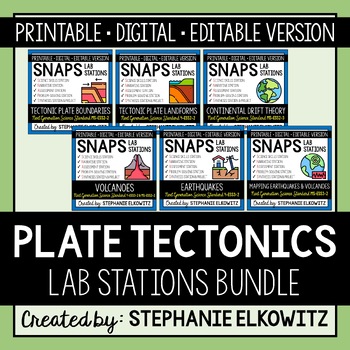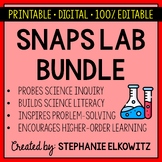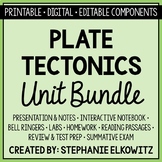Tectonic Plates Lab Stations Bundle | Printable, Digital & Editable
- Zip
- Google Apps™

Products in this Bundle (6)
showing 1-5 of 6 products
Also included in
- SAVE 50% by purchasing ALL my Earth Science Lab Stations Activities!About this ProductSNAPs Lab Stations Activities require students to use science, math, literacy, problem-solving and engineering skills. They are designed to enhance students' understanding of scientific concepts and help students aPrice $217.00Original Price $434.00Save $217.00
- SAVE MORE THAN 50% by purchasing ALL my Earth, Life, Physical & Nature of Science Lab Stations Activities!About this ProductSNAPs Lab Stations Activities require students to use science, math, literacy, problem-solving and engineering skills. They are designed to enhance students' understandingPrice $500.00Original Price $1631.00Save $1131.00
- Save 40% by purchasing ALL my Plate Tectonics teaching materials!Important Notes:• Download a FREE Unit Bundle to learn more about all my products.• Save $$$ with the Earth Science Complete Curriculum• Save $$$$ with the Integrated Science Complete Curriculum• Consider Daily Lessons as an economicalPrice $70.80Original Price $118.00Save $47.20
Description
SAVE 30% by purchasing ALL my Tectonic Plates Lab Stations Activities!
About SNAPs Lab Stations Activities
SNAPs Lab Stations require students to use science, math, literacy, problem-solving and engineering skills. They are designed to enhance students' understanding of scientific concepts and help students apply scientific ideas. Each station activity promotes skills so to develop students into proficient and competent scientific thinkers.
SNAPs lab activities have five components:
• Science Skills Station to develop science skill proficiency
• Narrative Station to build science literacy
• Assessment Station to evaluate learning and understanding
• Problem-Solving Station to foster engineering design
• Synthesis Station and Project to inspire higher-order learning
Important Notes:
• Download the FREE SNAPs Setup Guide for best practices, signage and editable rubrics
• Download a FREE SNAPs Lab Stations Activity to learn more about my SNAPs labs
• Save $$ with the NGSS Science Lab Stations Bundle ($500 for 200+ labs)
• Save $$$ with the Earth Science Complete Curriculum
• Save $$$$ with the Integrated Science Complete Curriculum
*********************************************************************************************************
DIGITAL LABORATORIES – DISTANCE LEARNING & DIGITAL CLASSROOMS
• Labs are offered in a digital format to support digital classrooms & distance learning.
• Each digital lab activity is designed to work with Google Slides and Microsoft PowerPoint
• Each digital lab activity CANNOT be edited. However:
- Students can manipulate text boxes
- Students can create tables, graphs and diagrams
- Students can insert images and drawings
GOOGLE FORM ASSESSMENT STATION
• Each assessment station is offered as a self-grading Google Form.
• Questions are all short answer and are 100% editable.
• Suggestions for use are included in the download.
DISTANCE LEARNING COMPATIBILITY
SNAPs lab activities are rated for their ease with distance – independent learning. Refer to the preview for each individual lab for more information about how well each lab works in a fully digital classroom and with distance learning.
*********************************************************************************************************
EDITABLE DOCUMENTS
This download includes an editable word document (docx file) of all lab components:
• Pre-Lab and Post-Lab Activities
• The Lab Overview
• Lab Station Activities and Questions
• Directed Synthesis Project (when applicable)
Important Notes:
• Diagrams, illustrations, tables and graphs essential to lab activities are included
• Illustrative clipart is NOT included
• Editable documents and rubrics are included with the FREE SNAPs Setup Guide
Editable files allow you to:
• Edit the scope of the activities so to suit your students’ needs
• Edit the materials required based on resource availability
• Create single-period “mini-labs” using activities at the individual skills stations
*********************************************************************************************************
This bundle includes:
• Tectonic Plate Boundaries (MS-ESS2-2)
• Tectonic Plate Boundary Landforms Lab Stations Activity (4-ESS2-2)
• Continental Drift Theory Lab Stations Activity (MS-ESS2-3)
• Volcanoes Lab Stations Activity (4-ESS3-2, MS-ESS2-2)
• Earthquakes Lab Stations Activity (4-ESS3-2, MS-ESS2-2)
• Earthquake and Volcano Mapping Lab Stations Activity (MS-ESS3-2)
Please view individual labs for objectives and station descriptions.
NEXT GENERATION SCIENCE STANDARDS
These labs satisfy Next Generation Science Standard 4-ESS2-2, 4-ESS3-2, MS-ESS2-2 and MS-ESS3-2. They combine the three dimensions of science learning - science and engineering practices, disciplinary core ideas and crosscutting concepts - to meet the standard. The labs also make interdisciplinary connections to STEM, Math CCSS and ELA CCSS to build the appropriate skills.
TERMS OF USE
• All rights reserved by Stephanie Elkowitz.
• This product is to be used by the original purchaser only.
• Intended for classroom and personal use only.
• Copying for more than one teacher, classroom, department, school, or school system is prohibited.
• This product may not be distributed or displayed digitally for public view.
• Failure to comply is a copyright infringement and a violation of the Digital Millennium Copyright Act (DMCA).





